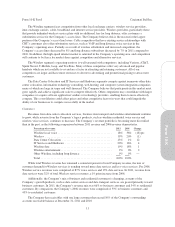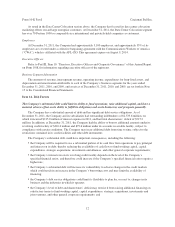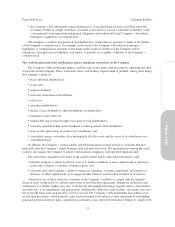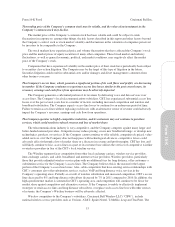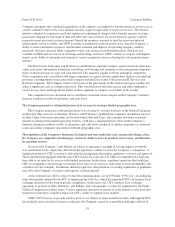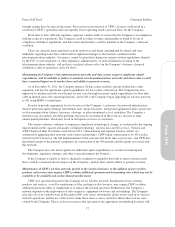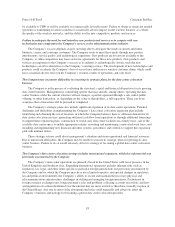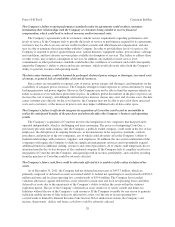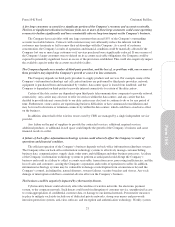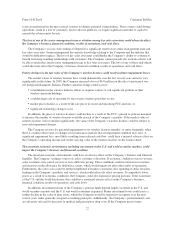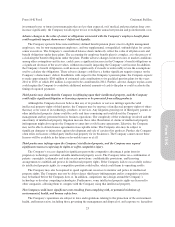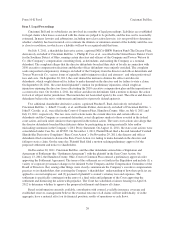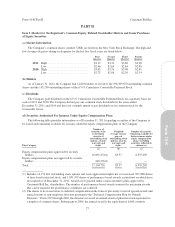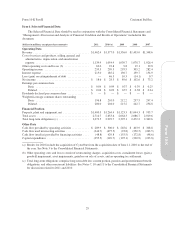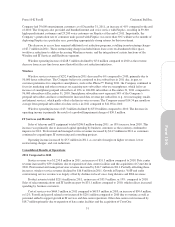Cincinnati Bell 2011 Annual Report Download - page 139
Download and view the complete annual report
Please find page 139 of the 2011 Cincinnati Bell annual report below. You can navigate through the pages in the report by either clicking on the pages listed below, or by using the keyword search tool below to find specific information within the annual report.
Form 10-K Part I Cincinnati Bell Inc.
A few large customers account for a significant portion of the Company’s revenues and accounts receivable.
The loss or significant reduction in business from one or more of these large customers could cause operating
revenues to decline significantly and have a materially adverse long-term impact on the Company’s business.
The Company has receivables with one large customer that exceed 10% of the Company’s outstanding
accounts receivable balance. Contracts with customers may not sufficiently reduce the inherent risk that
customers may terminate or fail to renew their relationships with the Company. As a result of customer
concentration, the Company’s results of operations and financial condition could be materially affected if the
Company lost one or more large customers or if services purchased were significantly reduced. If one or more of
the Company’s larger customers were to default on its accounts receivable obligations, the Company could be
exposed to potentially significant losses in excess of the provisions established. This could also negatively impact
the available capacity under the accounts receivable facility.
The Company depends on a number of third-party providers, and the loss of, or problems with, one or more of
these providers may impede the Company’s growth or cause it to lose customers.
The Company depends on third-party providers to supply products and services. For example, many of the
Company’s information technology and call center functions are performed by third-party providers, network
equipment is purchased from and maintained by vendors, data center space is leased from landlords, and the
Company is dependent on third-parties to provide internet connectivity to certain of the data centers.
Certain of the data centers are dependent upon third-party telecommunication companies to provide network
connectivity. Any carrier may elect not to offer its services within the data centers, and any carrier that has
decided to provide internet connectivity to our data centers may elect not to continue to do so for any period of
time. Furthermore, some carriers are experiencing business difficulties or have announced consolidations and
may be forced to downsize or terminate connectivity within the data centers, which could have an adverse affect
on the business.
In addition, almost half of the wireless towers used by CBW are managed by a single independent service
provider.
Any failure on the part of suppliers to provide the contracted services, additional required services,
additional products, or additional leased space could impede the growth of the Company’s business and cause
financial results to suffer.
A failure of back-office information technology systems could adversely affect the Company’s results of
operations and financial condition.
The efficient operation of the Company’s business depends on back-office information technology systems.
The Company relies on back-office information technology systems to effectively manage customer billing,
business data, communications, supply chain, order entry and fulfillment and other business processes. A failure
of the Company’s information technology systems to perform as anticipated could disrupt the Company’s
business and result in a failure to collect accounts receivable, transaction errors, processing inefficiencies, and the
loss of sales and customers, causing the Company’s reputation and results of operations to suffer. In addition,
information technology systems may be vulnerable to damage or interruption from circumstances beyond the
Company’s control, including fire, natural disasters, systems failures, security breaches and viruses. Any such
damage or interruption could have a material adverse effect on the Company’s business.
The business could be negatively impacted by cybersecurity threats.
Cybersecurity threats could adversely affect the wireline or wireless networks, the electronic payment
system, or the corporate network. Such threats could result in disruption of customer service, unauthorized access
to or misappropriation of confidential customer data, or damage to our internal network. Preventative measures
in place to mitigate such risks include use of dedicated private networks, strong user names and passwords,
intrusion protection systems, anti-virus software, and encryption and authentication technology. Weekly system
21
Form 10-K


